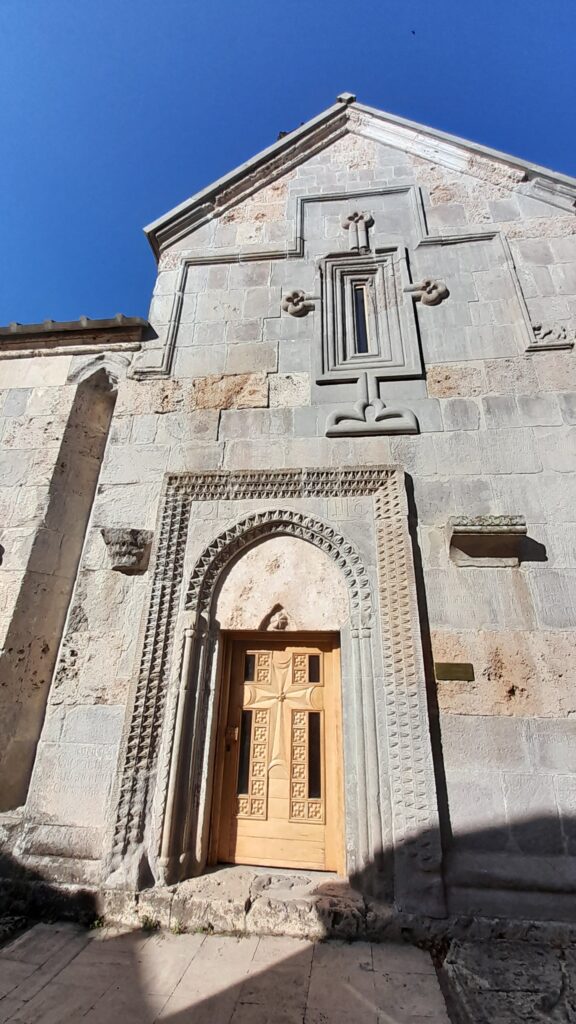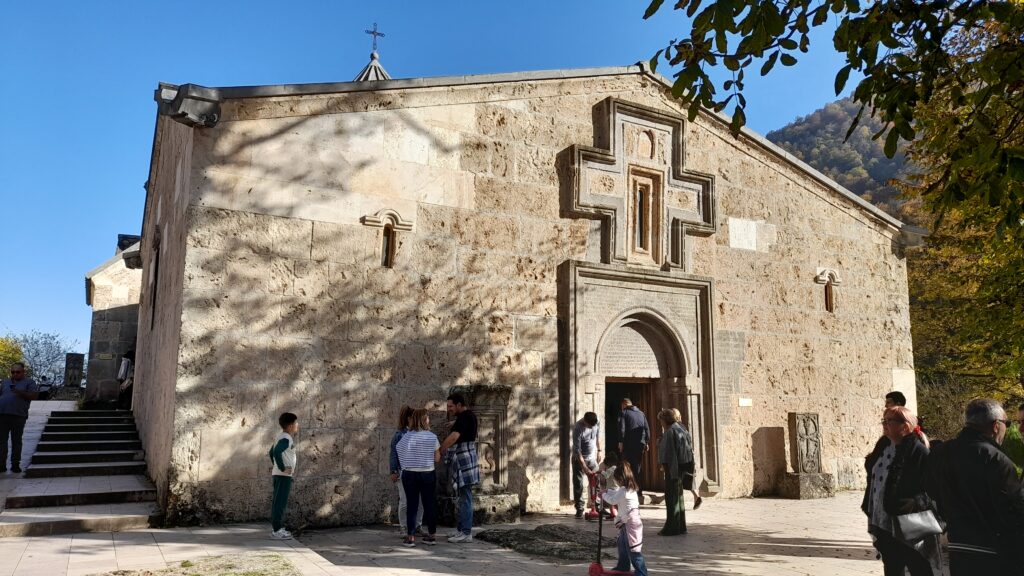Book now
Haghartsin Monastery: A Time-Tested Beauty in Armenia
Armenia, a country steeped in history and adorned with ancient wonders, holds a gem in its northeastern region — the Haghartsin Monastery. Nestled just 18 km north of Dilijan, this 13th-century marvel stands as a testament to Armenian medieval architecture, capturing the hearts of visitors with its rich history and captivating structures.
A Glimpse into the Past
The Haghartsin Monastery, an architectural masterpiece, began taking shape between the 10th and 13th centuries. Much of the construction occurred during the 12th century, generously supported by the Bagratuni dynasty. The very name of the monastery, “Haghartsin,” pays homage to an eagle, with “Artsin” translating to eagle in Armenian, a nod to the traditional belief that an eagle soared over the main building during its dedication.





St. Astvatsatsin Church
One cannot help but be enchanted by the St. Astvatsatsin Church, built in 1281. This sacred space features a distinctive sixteen-faced dome adorned with intricate architectural details. Sculptural elements grace the exterior, depicting monks, church models, and doves in a harmonious dance of stone.






Gavit Chronicles
Adjacent to the St. Astvatsatsin Church, the Gavit stands as a testament to the passage of time. Severely damaged, its ruins showcase the original structure despite significant destruction, offering a glimpse into the architectural prowess of the past.




St. Gregory Church
Dive into history with the St. Gregory Church, dating back to the 10th century. This ancient structure features an octagonal tambour and served as a pivotal school of church music. The connected Gavit, dating from the 12th century, reveals ornate corner sections adorned with human figure sculptures in monks’ attire.






St. Stepanos Church
Dating to 1244, the smaller St. Stepanos Church adds another layer of historical significance to the monastery complex. Its modest yet captivating presence contributes to the serene ambiance of Haghartsin.






Refectory
Step into the Refectory, a space reminiscent of Haghpat’s own. Built in 1248, this hall features stone benches, architectural decorations, and plays host to receptions. Its meticulous design incorporates symbolic elements, with domes resembling dormers supported by 12 columns representing Christ’s 12 Disciples.


A Glimpse into the Future
Haghartsin Monastery, though rooted in the past, looks toward the future. With discussions underway for its inclusion in the Dilijan National Park, an important forest area in northeastern Armenia, the monastery might soon find itself listed as a World Heritage site.
The Resilience of Haghartsin
Enduring wars and earthquakes, Haghartsin Monastery reached its peak prominence between the 12th and 13th centuries as a significant cultural and scientific center. Its structures, including the Church of the Holy Mother of God, St. Gregory, and St. Stephan’s, reflect the typical dome-shaped Armenian monasteries. They boast underground vaults, passages for escape during crises, and various facilities such as chapels, a dining hall, a bell tower, a library, and cells for monks.






The Refectory’s Hidden Symbolism
Beyond its architectural beauty, the Refectory reveals a deeper layer of symbolism. Meticulous in design, it represents the intersection of history and faith. The domes, resembling dormers, and the 12 columns are a poignant nod to Christ’s 12 Disciples, inviting visitors to contemplate the spiritual significance embedded in the very stones.
Haghartsin Monastery not only served as a religious center but also as a hub of knowledge and scientific inquiry. Knowledgeable monks inhabited the monastery, using sundials to calculate time for worship. The various facilities, including chapels and a library, facilitated secluded worship, showcasing the monastery’s multifaceted role in the community.
Accessibility and Renovation
As of 2011, Haghartsin Monastery underwent significant renovation, breathing new life into its ancient stones. The complex is now easily accessible, welcoming visitors with added facilities such as parking and a gift shop. It has also been incorporated into the Transcaucasian Trail hiking route, offering adventurers a chance to explore the breathtaking landscapes surrounding the monastery.
Location: Teghut 3902, Armenie
Conclusion
Traveling to Haghartsin Monastery is an enriching experience, and reaching this historical gem is an adventure in itself. Whether by train, bus, taxi, or car from Yerevan, Armenia’s capital, the journey involves a multi-step exploration either via public transport or private means. Whichever route you choose, the anticipation builds as you draw closer to the captivating beauty of Haghartsin.
Haghartsin Monastery stands not only as a testament to Armenia’s rich history and architectural prowess but also as a timeless sanctuary that continues to captivate hearts and minds.
People also read:
- 45 Things to See and Do in Armenia
- Unveiling the Mysteries of Garni Temple in Armenia
- 25 Things to See and Do in Yerevan
- Exploring the Beauty of Geghard Monastery in Armenia
- Khor Virap Monastery: Unveiling Armenia’s Historical Gem
- Areni Cave: Unearthing Millennia of History and Discoveries
- Yerevan in 25 Photos
- Saghmosavank Monastery: A Timeless Marvel in Armenian History
- Noravank Monastery: A Journey Through Time
- Amberd Fortress: A Citadel in the Clouds
- Etchmiadzin Cathedral: A Beacon of Armenian Christianity
- Zvartnots Cathedral
- Exploring Odzun Church: A Hidden Gem in Armenia
- Akhtala Monastery Complex in Armenia
- Haghpat Monastery: A Timeless Beauty in Armenia
- Armenia in 50 Photos
- Sevanavank: A Pearl on Lake Sevan’s Shoreline
Spend the night in Armenia
Book a tour
FAQ’s
Read more articles on my Armenia page
This article may contain affiliate links. This means that we receive a small commission when you book something via these links. Of course, this does not cost you anything extra. Did our tips help you? We would love it if you book your trip via the links in the article above. Thank you so much.